skills acTion Plan for The food and Beverage secTor - Department of ...
skills acTion Plan for The food and Beverage secTor - Department of ...
skills acTion Plan for The food and Beverage secTor - Department of ...
You also want an ePaper? Increase the reach of your titles
YUMPU automatically turns print PDFs into web optimized ePapers that Google loves.
SKILLS WORKING GROUP PRIORITIES<br />
<strong>The</strong> following sections outline key labour market issues<br />
under each <strong>of</strong> the three Skills Working Group priorities<br />
- better labour market in<strong>for</strong>mation, more strategic<br />
investment in training <strong>and</strong> attractive careers.<br />
1. Better Labour Market In<strong>for</strong>mation<br />
<strong>The</strong> purpose <strong>of</strong> this priority is to ensure robust data <strong>and</strong><br />
in<strong>for</strong>mation is available to enable sound decision making<br />
about <strong>food</strong> <strong>and</strong> beverage <strong>skills</strong>, training, employment <strong>and</strong><br />
productivity issues. This priority includes improving the<br />
in<strong>for</strong>mation base by:<br />
• Being able to <strong>for</strong>ecast labour dem<strong>and</strong> in sub sectors<br />
within <strong>food</strong> <strong>and</strong> beverage.<br />
• Better underst<strong>and</strong>ing <strong>of</strong> the link between productivity<br />
<strong>and</strong> <strong>skills</strong> in <strong>food</strong> <strong>and</strong> beverage businesses.<br />
• Better underst<strong>and</strong>ing <strong>of</strong> how to increase the adoption<br />
<strong>of</strong> science <strong>and</strong> technology in <strong>food</strong> <strong>and</strong> beverage<br />
businesses.<br />
• Determining the extent <strong>of</strong> current <strong>skills</strong> shortages in<br />
key <strong>food</strong> <strong>and</strong> beverage occupations.<br />
Each <strong>of</strong> these components is explained in detail below.<br />
1.1 FORECASTING FRAMEWORK<br />
Action Points<br />
• <strong>The</strong> <strong>food</strong> <strong>and</strong> beverage <strong>for</strong>ecasting framework will<br />
be implemented <strong>and</strong> applied to all <strong>food</strong> <strong>and</strong> beverage<br />
sub-sectors <strong>and</strong> maintained on an ongoing basis.<br />
This would involve <strong>food</strong> <strong>and</strong> beverage ITOs (as part <strong>of</strong><br />
their strategic <strong>skills</strong> leadership role) assisting in the<br />
implementation <strong>of</strong> the framework in conjunction with<br />
other relevant organisations.<br />
• STAG will guide consistency <strong>of</strong> application <strong>of</strong> this<br />
framework within the <strong>food</strong> <strong>and</strong> beverage sector,<br />
improve the framework, <strong>and</strong> test its robustness<br />
with respective industry organisations <strong>and</strong> training<br />
organisations.<br />
Background<br />
A <strong>for</strong>ecasting framework <strong>for</strong> the <strong>food</strong> <strong>and</strong> beverage sector<br />
was considered necessary to process relevant <strong>and</strong> available<br />
labour market in<strong>for</strong>mation using appropriate modelling <strong>of</strong><br />
future labour <strong>and</strong> <strong>skills</strong> dem<strong>and</strong> in the sector. A <strong>for</strong>ecasting<br />
framework has been developed by BERL (Business <strong>and</strong><br />
Economic Research Ltd) <strong>and</strong> tested on the dairy <strong>and</strong> wine<br />
sub-sectors, which included industry consultation. This<br />
framework is designed to be used by industry organisations<br />
to assist in their work<strong>for</strong>ce planning.<br />
<strong>The</strong> numbers generated <strong>for</strong> the dairy <strong>and</strong> wine sub-sectors<br />
are not <strong>for</strong>ecasts, rather they provide an outlook <strong>for</strong> the<br />
sub-sectors <strong>and</strong> are the result <strong>of</strong> specified scenarios<br />
which demonstrate how the framework can function.<br />
<strong>The</strong> framework is a starting point requiring further work,<br />
industry ownership, data integrity <strong>and</strong> interpretation <strong>of</strong><br />
facts <strong>and</strong> trends that are identified as a result <strong>of</strong> ‘running<br />
the numbers’. <strong>The</strong> interpretation is necessary within a<br />
strategic context that includes the impacts <strong>of</strong> ‘s<strong>of</strong>t’<br />
influencing factors on the flows <strong>of</strong> labour.<br />
This framework will enable the <strong>food</strong> <strong>and</strong> beverage sector,<br />
education <strong>and</strong> training organisations, industry associations<br />
<strong>and</strong> government agencies to make better assessments<br />
about future labour <strong>and</strong> skill needs in this sector <strong>and</strong> how<br />
to address them. It may assist in education, training <strong>and</strong><br />
recruitment decisions <strong>and</strong> assist the task<strong>for</strong>ce in planning<br />
its development agenda. <strong>The</strong>re is a distinct need <strong>for</strong><br />
projections <strong>of</strong> the trends in the dem<strong>and</strong> <strong>for</strong> labour over the<br />
medium term in relation to future growth or changes in the<br />
<strong>food</strong> <strong>and</strong> beverage sector.<br />
<strong>The</strong> framework needs to be further tested with respect<br />
to the assumptions (labour turnover, productivity, output<br />
growth, extent <strong>of</strong> part-time work) used <strong>and</strong> integrity <strong>of</strong> the<br />
data. It could then be extended to other <strong>food</strong> <strong>and</strong> beverage<br />
sub-sectors. It will be critical to improve the in<strong>for</strong>mation<br />
used in the framework <strong>and</strong> data updates, including use<br />
<strong>of</strong> the 2006 Census in<strong>for</strong>mation on occupations <strong>and</strong><br />
qualifications within the <strong>food</strong> <strong>and</strong> beverage sector. In<br />
implementing this framework, future population changes<br />
22



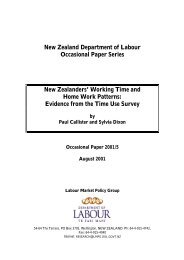

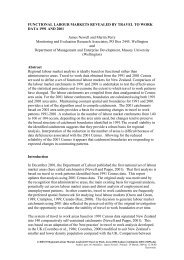
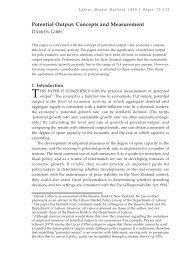

![a note on levels, trends, and some implications [pdf 21 pages, 139KB]](https://img.yumpu.com/27285836/1/184x260/a-note-on-levels-trends-and-some-implications-pdf-21-pages-139kb.jpg?quality=85)


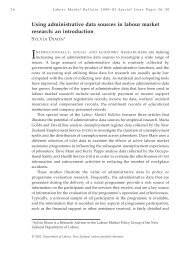
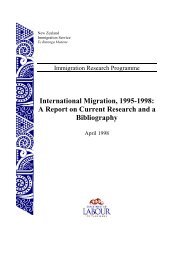

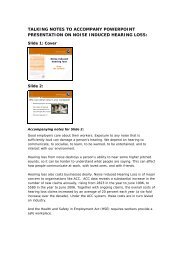
![Labour Market Trends and Outlook - 1996 [pdf 18 pages, 94KB]](https://img.yumpu.com/27285764/1/184x260/labour-market-trends-and-outlook-1996-pdf-18-pages-94kb.jpg?quality=85)

